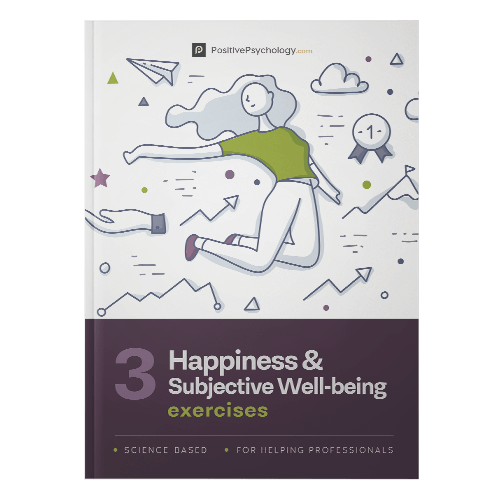What Is Social Wellbeing? 12+ Activities for Social Wellness
 We know humans are social beings.
We know humans are social beings.
Yet, when thinking about wellbeing, we think more about our individual wellbeing, in terms of how good we feel, how satisfied we are with our lives, and how well we are functioning in different areas.
We might think about positive relationships as a part of functioning well. However, there is more to social wellbeing than that.
It is not only our social interactions, but also our relationships with our communities and social structures that constitute a key and distinct domain of wellbeing.
For this article, we will discuss social wellbeing at the levels of positive relationships (e.g., friends, family, romantic partner) and larger systems (e.g., school, workplace, culture).
Before you continue, we thought you might like to download our three Happiness & Subjective Wellbeing Exercises for free. These detailed, science-based exercises will help you or your clients identify sources of authentic happiness and strategies to boost wellbeing.
This Article Contains:
- What Is Social Wellbeing in Psychology?
- 7 Real-Life Examples
- 4 Popular Theories and Indicators
- Positive Psychology’s Role in Social Wellbeing
- A Look at Social Wellbeing in the Workplace
- Measuring Social Wellbeing: 3 Questionnaires & Scales
- How to Improve Social Wellbeing: 6 Activities
- PositivePsychology.com’s Resources
- A Take-Home Message
- References
What Is Social Wellbeing in Psychology?
Social wellbeing has definitions emerging from a range of fields. In this article, we will explore social wellbeing specifically within the field of psychology.
Social researcher Corey Keyes is one pioneer in this area, proposing a theoretical model to understand and study social wellbeing, expanding on Carol Ryff’s psychological wellbeing model (Ryff & Keyes, 1995). Keyes (1998) defines social wellbeing as “the subjective evaluation of personal life circumstances and functioning in society.”
In general terms, social wellbeing can be defined as developing and maintaining positive interactions with other people and with local and global communities. This is mainly assessed through subjective and individual measures, where people assess the quality of those interactions according to their own perceptions (Cicognani, Martinengo, Albanesi, Piccoli, & Rollero, 2014).
Subjective wellbeing, psychological wellbeing, and social wellbeing are distinct constructs but intricately correlated. Joshanloo, Sirgy, and Park (2018) showed that social wellbeing can predict subjective wellbeing over time, but subjective wellbeing is less likely to predict social wellbeing.
These findings support Self-Determination Theory; indeed, basic psychological needs – relatedness in particular – precede individual wellbeing.
When comparing some of the most well-known wellbeing frameworks and scales used to measure flourishing, positive relationships and social contribution emerge as common elements (Hone, Jarden, Schofield, & Duncan, 2014). These overlaps reveal the importance of social connections to wellbeing.
However, there is a lack of agreement in terms of how to conceptualize and measure social wellbeing. One standpoint is to consider it as one domain of individual wellbeing (e.g., as in the PERMA model), while another view is to conceive it as a separate construct and external force that influences health (Cicognani et al., 2014).
Benefits of positive relationships
Social interactions, both in terms of quality and quantity, can have a short- and long-term influence on mental wellbeing and physical health. Research suggests that romantic relationships can be a central source of wellbeing for adolescents and young adults (Gómez-López, Viejo, & Ortega-Ruiz, 2019), and that support from friends is associated with higher levels of resilience (Secor, Limke-McLean, & Wright, 2017).
Friendships can be seen as a valued source of instrumental, relational, and emotional support that can enhance family support (Amati, Rivellini, & Zaccarin, 2015). Both the frequency of friendship interactions (intensity) and individual satisfaction with those relationships (quality) have been positively associated with life satisfaction (Amati, Meggiolaro, Rivellini, & Zaccarin, 2018).
Furthermore, higher levels of subjective wellbeing are positively associated with the number of friends a person can trust and disclose intimate matters with, but decline as the number of acquaintances or strangers increases (Powdthavee, 2008).
Research shows the value of having a variety of social connections in addition to the depth and quality of those interactions. Moreover, the links between positive relationships, health, and wellbeing can be explained through three pathways (Umberson & Karas Montez, 2010):
- Behavioral
Social bonds such as those with partners and friends can influence our health habits and behaviors, which can influence our health and longevity. - Psychosocial
Social support can reduce stress and enhance emotional and psychological wellbeing, positively influencing health behaviors and physical health. - Physiological
Positive relationships can boost cardiovascular, immune, and endocrine responses, which can affect longevity and health in the long run.
7 Real-Life Examples

To increase your social wellbeing, consider the following activities:
- Keeping regular contact with your friends.
- Spending quality time with your loved ones.
- Engaging in volunteer work.
- Taking classes at a local community center.
- Joining a group based on your interests.
- Celebrating your traditions and culture.
- Participating in community events.
4 Popular Theories and Indicators
Here we explore four theories and frameworks that describe and explain different aspects of social relationships and wellbeing.
1. Attachment theory
Attachment is an ongoing psychological bond with a specific person (Bowlby, 1982/1969), and attachment theory explains the development of different bonds based on affect regulation from an early stage in life, resulting in a sense of security/insecurity and healthy/unhealthy attachment styles and behaviors (Ainsworth, 1973; Bowlby, 1988).
A secure attachment style derives from a perception of the world as safe and trustworthy, and the use of security-based strategies to relate to others. This translates into people being able to more actively and constructively manage negative affect, and experiencing and using creativity because of positive affect (Mikulincer, Shaver, & Pereg, 2003).
2. The need for belongingness
In their seminal article The Need to Belong, Baumeister and Leary (1995) made a case for belongingness as a basic human need. Based on empirical evidence, they proposed that humans have the need to develop and sustain positive, lasting, and significant relationships.
The presence of relationships was associated with subjective wellbeing and physical health, whereas the lack of them correlated with depressive and anxiety symptoms, jealousy, suicide, and ill health (Baumeister & Leary, 1995).
Since then, interest and research in this area has grown. Evidence shows that belongingness can enhance cognitive processes, emotions, and behaviors, whereas unmet needs for belonging can have negative short- and long-term consequences in these areas (Gere & MacDonald, 2010).
3. Relationships Motivation Theory
Self-Determination Theory (SDT) posits that human beings have three basic psychological needs: autonomy, competence, and relatedness. The latter refers to experiencing reciprocity in terms of acceptance, significance, and care in close relationships, and it is considered inherently satisfying (Deci & Ryan, 2000).
Relationships Motivation Theory (RMT) is a sub-theory within SDT that emphasizes the value of not only the presence of relationships, but also the quality of those relationships in meeting relatedness needs (Deci & Ryan, 2014). RMT also posits that thriving relationships demand the satisfaction of the other two basic needs within relationships, especially the need for autonomy.
Deci and Ryan (2014) argue that partners involved in a relationship need to provide autonomy support and experience autonomy in order to see the relationship as highly satisfying and high quality. Furthermore, research by La Guardia, Ryan, Couchman, and Deci (2000) suggests that autonomy was a significant predictor of attachment security not only in partners, but also in peer and parental relationships.
4. Social wellbeing
Keyes (1998) refers to this construct as positive social health or wellness, which is conceived as mainly representing public phenomena. From this standpoint, wellbeing is focused on social duties adults face in their lives and how they balance individual and social worlds (Cicognani et al., 2014).
Social wellbeing (Keyes, 1998) comprises five indicators of the presence of and extent to which an individual is facing social challenges and navigating their social reality:
- Social integration is the sense of being a part of a community and society based on the appraisal of the quality of that relationship.
- Social acceptance is the acknowledgment of a social construal based on certain positive qualities of a given group.
- Social contribution is the assessment of our personal value and contribution to society or a community.
- Social actualization refers to our evaluation of the potential and evolution of society
- Social coherence involves an interest about the world and an appraisal about the organization, operation, and quality of society.
Social well being – importance of social connections – Whats Up Dude
Positive Psychology’s Role in Social Wellbeing
Positive psychology has contributed to the advancement of social wellbeing by studying prosocial emotions and behaviors, and more recently, through the lens of systems science.
Prosocial emotions
Gratitude is a positive emotion that arises when we acknowledge that someone or something external has benefited us (Emmons & McCullough, 2003). Several interventions have been developed to promote gratitude and enhance positive emotions and physical health, as well as decrease depressive symptoms (Wood, Froh, & Geraghty, 2010).
But the benefits of gratitude transcend the individual realm and can also benefit the people inspiring gratitude in others. Communicating gratitude to friends, family, or romantic partners can strengthen the bond of those connections (Lambert, Clark, Durtschi, Fincham, & Graham, 2010).
Compassion is a feeling that emerges when observing other people’s suffering, provoking a desire to relieve such suffering (Goetz, Keltner, & Simon-Thomas, 2010). Goetz et al. (2010) propose that compassion has played a key role in evolution, promoting cooperation and motivating us to protect those who we perceive to be weak or vulnerable in a group.
There are three types of compassion that are intimately related: compassion toward others, compassion from others, and self-compassion (Gilbert, Laschinger, & Leiter, 2010; Neff, 2003).
Self-compassion is positively associated with being able to both receive compassion from others and express compassion toward others (Jazaieri et al., 2013).
Prosocial behavior
Prosocial emotions are closely related to prosocial behavior. Gratitude in particular has been proposed as interacting with kindness in a positive feedback spiral, creating reciprocity between givers and receivers (Aknin, Dunn, & Norton, 2012).
Doing acts of kindness is correlated to increases in happiness (Dunn, Aknin, & Norton, 2008), and people who engage in volunteer work are healthier (Jenkinson et al., 2013). However, the effects on subjective wellbeing may be moderate (Curry et al., 2018).
Sustainable behavior entails a set of actions toward protecting our physical and social environments, and it is underpinned by altruism, fairness, frugality, and a positive attitude toward ecosystems (Corral-Verdugo, Mireles-Acosta, Tapia-Fonllem, & Fraijo-Sing, 2011).
Different studies have positively linked each of these facets to happiness independently. One study looking at these four components of sustainable behavior concurrently found that increased levels of each behavior are associated with greater levels of subjective wellbeing (Corral-Verdugo et al., 2011).
Systems informed positive psychology
Beyond optimal individual functioning, systems informed positive psychology (SIPP) draws on principles and applications of systems science to provide a new perspective into wellbeing. The aim of SIPP is “to cultivate the wellbeing of human social systems, enable system co-evolution and create positive unimagined futures” (Kern et al., 2020, p. 4).
From a SIPP point of view, people are embedded in wider and complex social systems, with different conceptions of how wellbeing is understood and what outcomes are more valued (Lomas, Waters, Williams, Oades, & Kern, 2020).
SIPP aims to capture the voices of social minorities and cultural diversity, and visualizes wellbeing as a shared responsibility at an individual as well as an institutional and macro-system level. This entails creating conditions within the larger systems to support, enhance, and sustain both individual and communal wellbeing (Kern et al., 2020).
One application of SIPP is taking a systems approach to wellbeing in the workplace, considering the role of prosocial emotions and behaviors.
A Look at Social Wellbeing in the Workplace

While suffering within an organization can be pervasive and entail financial, emotional, and physical costs, compassion at work can yield individual benefits in terms of better physical and mental health, decreased symptoms, and the promotion of healing from ill health (Dutton et al., 2014).
Waters (2012) conducted a study assessing gratitude practices at an individual and organizational level in a workplace setting. The evidence shows that organizational gratitude interventions and embedding gratitude practices into the organizational culture could enhance and sustain job satisfaction.
High-quality connections (HQCs) are short-lived dyadic relationships that the people involved perceive to be positive because of the uplifting sensation that a genuine interest can spark in them (Stephens, Heaphy, & Dutton, 2012).
The underlying rationale is that relationships contribute to individual growth, with social support and trust being key in the development of organizational features such as cooperation and trustworthiness.
HQCs have been correlated with several organizational and individual outcomes, including performance and health (Stephens et al., 2012). Interestingly, the interaction between cognitive, emotional, and behavioral individual mechanisms and the organizational practices can amplify or diminish outcomes.
Measuring Social Wellbeing: 3 Questionnaires & Scales
Generally speaking, social wellbeing measurements use an individual and subjective approach.
Here we explore three self-report measurements of social wellbeing.
1. Health-Related Quality of Life
This measure conceptualizes social wellbeing as comprising two dimensions: social functioning and social support.
Social functioning addresses the level of satisfaction with relationships, while social support refers to the extent to which a person feels they can trust and rely on others (McDowell & Newell, 1987).
More information on this scale can be obtained from the U.S. Centers for Disease Control and Prevention.
2. Mental Health Continuum–Short Form (MHC-SF)
Keyes (1998) developed a scale to measure the five dimensions of social wellbeing included in his model.
The original questionnaire measured social wellbeing using five scales, each comprising three items, and was included in the Mental Health Continuum–Long Form along with scales to assess emotional and psychological wellbeing.
The MHC-SF uses one prototypical item to represent and measure each dimension of social wellbeing. This form has shown validity and reliability, and has been translated to several languages (Keyes & Annas, 2009).
3. European Social Survey (ESS) Wellbeing Module
The European Social Survey (ESS) Wellbeing Module was designed to measure interpersonal and social aspects of wellbeing in European populations, based on the theoretical notion that the relationships a person has in society and with others contribute to their subjective wellbeing (Huppert et al., 2009; Huppert & So, 2013).
The ESS Wellbeing Module assesses social wellbeing in terms of feelings (e.g., belonging, social support, social progress, and social recognition) and functioning (e.g., altruism, engagement, and caring).
More information on this scale can be obtained from Reach Cambridge.
How to Improve Social Wellbeing: 5 Activities

Here is a quick overview of some of the activities.
1. Expressing Gratitude to Others
Engaging in gratitude reflection such as journaling, writing a letter, and communicating gratitude to others can improve wellbeing, increase positive affect, reduce negative affect, and promote optimism and prosocial behaviors (Emmons & McCullough, 2003; Seligman, Steen, Park, & Peterson, 2005).
There are many ways to increase the gratitude you express to others, and this Expressing Gratitude worksheet has several brilliant suggestions.
2. Random and Consistent Acts of Kindness
Doing either spontaneous or carefully planned acts of kindness can foster feelings of wellbeing (Passmore & Oades, 2015).
Use our Random and Consistent Acts of Kindness worksheet with seven tips to support a feeling of wellbeing.
3. Loving Kindness Meditation (LKM)
Loving kindness meditation encourages the intentional cultivation of feelings of love and compassion toward others.
LKM can increase feelings of connectedness and foster positive emotions, even when there is no direct interaction with the other person (Hutcherson, Seppala, & Gross, 2008).
If you are unsure how to start, this Loving Kindness Meditation worksheet provides you with easy-to-follow steps.
4. Capitalizing positive emotions with Active Constructive Responding
Capitalization comprises sharing positive experiences with others, and it is positively associated with higher intensity and frequency of positive emotions, surpassing the levels evoked by the original event (Gable, Reis, Impett, & Asher, 2004).
However, capitalization can backlash if the listener does not engage in the conversation with an active and constructive response (Quoidbach, Mikolajczak, & Gross, 2015).
Active constructive responding (ACR) reflects a genuine, honest, and enthusiastic interest in the other person (Gable et al., 2004). Explore this ACR worksheet to learn more about ACR and four types of responding to someone else’s good news.
5. High-Quality Relationships
High-quality relationships (HQRs) have three key functional features (Carmeli, Brueller, & Dutton, 2009):
- High emotional carrying capacity for positive and negative emotions
- High flexibility in the face of adversity and change
- High connectivity and openness to new ideas and influences
Additionally, HQRs possess three distinct aspects in terms of the subjective experience. According to Dutton and Heaphy (2003), people engaging in HQRs commonly experience vitality, positive regard, and mutuality.
Our High-Quality Relationships worksheet asks readers to consider the different features of HQRs and how they may improve them.
PositivePsychology.com’s Resources
Here we have collated a selection of interesting resources to complement the activities above.
Gratitude Journaling can help you strengthen your connection to others by acknowledging and appreciating what other people have contributed to your life. This can be useful to try out before openly expressing gratitude to others.
These worksheets on Listening Accurately and Active Listening can help you capitalize positive emotions in your relationships when someone shares positive news with you.
These worksheets on Effective Communication and Improving Communication in Relationships can help you develop other relevant elements when communicating with others.
The Connection Ritual worksheet can be useful for improving the quality of your personal relationships.
If you’re looking for more science-based ways to help others develop strategies to boost their wellbeing, this collection contains 17 validated happiness and wellbeing exercises. Use them to help others pursue authentic happiness and work toward a life filled with purpose and meaning.
A Take-Home Message
In general, we have all felt the relevance of social connection at various points in our lives.
Shared challenges and the emergence of different social movements around climate change and social justice remind us of our interconnectedness and common humanity.
My invitation to you is to think about how each of us can contribute to our common wellbeing. Feel free to share your ideas in the comments below.
We hope you enjoyed reading this article. Don’t forget to download our three Happiness Exercises for free.
- Ainsworth, M. (1973). The development of infant-mother attachment. In B. Caldwell & H. Ricciuti (Eds.), Review of child development research (vol. 3)(pp. 1–94). University of Chicago Press.
- Aknin, L. B., Dunn, E. W., & Norton, M. I. (2012). Happiness runs in a circular motion: Evidence for a positive feedback loop between prosocial spending and happiness. Journal of Happiness Studies, 13(2), 347–355.
- Amati, V., Meggiolaro, S., Rivellini, G., & Zaccarin, S. (2018). Social relations and life satisfaction: The role of friends. Genus, 74(1), 1–18.
- Amati, V., Rivellini, G., & Zaccarin, S. (2015). Potential and effective support networks of young Italian adults. Social Indicators Research 122(3), 807–831.
- Baumeister, R. F., & Leary, M. R. (1995). The need to belong: Desire for interpersonal attachments as a fundamental human motivation. Psychological bulletin, 117(3), 497–529.
- Bowlby, J. (1988). A secure base: Parent–child attachment and healthy human development. Basic Books.
- Bowlby, J. (1982/1969). Attachment and loss: Vol. 1. Attachment (2nd ed.). Basic Books.
- Carmeli, A., Brueller, D., & Dutton, J. E. (2009). Learning behaviours in the workplace: The role of high-quality interpersonal relationships and psychological safety. Systems Research and Behavioral Science: The Official Journal of the International Federation for Systems Research, 26(1), 81–98.
- Cicognani, E., Martinengo, L., Albanesi, C., Piccoli, N., & Rollero, C. (2014). Sense of community in adolescents from two different territorial contexts: The moderating role of gender and age. Social Indicators Research, 119(3), 1663–1678.
- Corral-Verdugo, V., Mireles-Acosta, J. F., Tapia-Fonllem, C., & Fraijo-Sing, B. (2011). Happiness as correlate of sustainable behavior: A study of pro-ecological, frugal, equitable and altruistic actions that promote subjective wellbeing. Human Ecology Review, 18(2), 95–104.
- Curry, O. S., Rowland, L. A., Van Lissa, C. J., Zlotowitz, S., McAlaney, J., & Whitehouse, H. (2018). Happy to help? A systematic review and meta-analysis of the effects of performing acts of kindness on the well-being of the actor. Journal of Experimental Social Psychology, 76, 320-329.
- Deci, E. L., & Ryan, R. M. (2000). The “what” and “why” of goal pursuits: Human needs and the self-determination of behavior. Psychological inquiry, 11(4), 227–268.
- Deci, E. L., & Ryan, R. M. (2014). Autonomy and need satisfaction in close relationships: Relationships motivation theory. In N. Weinstein (Ed.), Human motivation and interpersonal relationships: Theory, research, and applications (pp. 53–73). Springer Science + Business Media.
- Dunn, E. W., Aknin, L. B., & Norton, M. I. (2008). Spending money on others promotes happiness. Science, 319(5870), 1687–1688.
- Dutton, J. E., Workman, K. M., & Hardin, A. E. (2014). Compassion at work. Retrieved from https://ecommons.cornell.edu/bitstream/handle/1813/71478/ Workman1_Compassion_at_Work.pdf?sequence=1
- Dutton, J. E., & Heaphy, E. D. (2003). The power of high-quality relationships at work. In K. S. Cameron, J. E. Dutton, & R. E. Quinn (Eds.), Positive organizational scholarship (pp. 263–278). Berrett-Koehler Publishers.
- Emmons, R. A., & McCullough, M. E. (2003). Counting blessings versus burdens: An experimental investigation of gratitude and subjective well-being in daily life. Journal of Personality and Social Psychology, 84(2), 377–389.
- Gable, S. L., Reis, H. T., Impett, E. A., & Asher, E. R. (2004). What do you do when things go right? The intrapersonal and interpersonal benefits of sharing positive events. Journal of Personality and Social Psychology, 87(2), 228–245.
- Gere, J., & MacDonald, G. (2010). An update of the empirical case for the need to belong. Journal of Individual Psychology, 66(1), 93–115.
- Gilbert, S., Laschinger, H. K., & Leiter, M. (2010). The mediating effect of burnout on the relationship between structural empowerment and organizational citizenship behaviours. Journal of Nursing Management, 18(3), 339–348.
- Goetz, J. L., Keltner, D., & Simon-Thomas, E. (2010). Compassion: An evolutionary analysis and empirical review. Psychological Bulletin, 136(3), 351–374.
- Gómez-López, M., Viejo, C., & Ortega-Ruiz, R. (2019). Psychological well-being during adolescence: Stability and association with romantic relationships. Frontiers in Psychology, 10, 1772.
- Hone, L. C., Jarden, A., Schofield, G. M., & Duncan, S. (2014). Measuring flourishing: The impact of operational definitions on the prevalence of high levels of wellbeing. International Journal of Wellbeing, 4(1), 62–90.
- Huppert, F. A., Marks, N., Clark, A., Siegrist, J., Stutzer, A., Vittersø, J., & Wahrendorf, M. (2009). Measuring well-being across Europe: Description of the ESS Well-Being Module and preliminary findings. Social Indicators Research, 91(3), 301–315.
- Huppert, F. A., & So, T. C. (2013). Flourishing across Europe: Application of a new conceptual framework for defining well-being. Social Indicators Research, 110(3), 837–861.
- Hutcherson, C. A., Seppala, E. M., & Gross, J. J. (2008). Loving-kindness meditation increases social connectedness. Emotion, 8(5), 720–724.
- Jazaieri, H., Jinpa, G. T., McGonigal, K., Rosenberg, E. L., Finkelstein, J., Simon-Thomas, E., … Goldin, P. R. (2013). Enhancing compassion: A randomized controlled trial of a compassion cultivation training program. Journal of Happiness Studies, 14(4), 1113–1126.
- Jenkinson, C. E., Dickens, A. P., Jones, K., Thompson-Coon, J., Taylor, R. S., Rogers, M., … Richards, S. H. (2013). Is volunteering a public health intervention? A systematic review and meta-analysis of the health and survival of volunteers. BMC Public Health, 13(1), 1–10.
- Joshanloo, M., Sirgy, M. J., & Park, J. (2018). Directionality of the relationship between social well-being and subjective well-being: Evidence from a 20-year longitudinal study. Quality of Life Research, 27(8), 2137–2145.
- Kern, M. L., Williams, P., Spong, C., Colla, R., Sharma, K., Downie, A., … Oades, L. G. (2020). Systems informed positive psychology. The Journal of Positive Psychology, 15(6), 705–715.
- Keyes, C. L. M. (1998). Social well-being. Social Psychology Quarterly, 61(2), 121–140.
- Keyes, C. L. M., & Annas, J. (2009). Feeling good and functioning well: Distinctive concepts in ancient philosophy and contemporary science. Journal of Positive Psychology, 4(3), 197–201.
- La Guardia, J. G., Ryan, R. M., Couchman, C. E., & Deci, E. L. (2000). Within-person variation in security of attachment: A self-determination theory perspective on attachment, need fulfillment, and well-being. Journal of Personality and Social Psychology, 79(3), 367–384.
- Lambert, N. M., Clark, M. S., Durtschi, J., Fincham, F. D., & Graham, S. M. (2010). Benefits of expressing gratitude: Expressing gratitude to a partner changes one’s view of the relationship. Psychological Science, 21(4), 574–580.
- Lomas, T., Waters, L., Williams, P., Oades, L. G., & Kern, M. L. (2020). Third wave positive psychology: Broadening towards complexity. The Journal of Positive Psychology, 1–15.
- McDowell, I., & Newell, C. (1987). Measuring health: A guide to rating scales and questionnaires. Oxford University Press.
- Mikulincer, M., Shaver, P. R., & Pereg, D. (2003). Attachment theory and affect regulation: The dynamics, development, and cognitive consequences of attachment-related strategies. Motivation and Emotion, 27(2), 77–102.
- Neff, K. (2003). Self-compassion: An alternative conceptualization of a healthy attitude toward oneself. Self and Identity, 2(2), 85–101.
- Passmore, J., & Oades, L. G. (2015). Positive psychology techniques: Random acts of kindness and consistent acts of kindness and empathy. The Coaching Psychologist, 11(2) 90–92.
- Powdthavee, N. (2008). Putting a price tag on friends, relatives, and neighbours: Using surveys of life satisfaction to value social relationships. The Journal of Socio-Economics, 37(4), 1459–1480.
- Ryff, C. D., & Keyes, C. L. M. (1995). The structure of psychological well-being revisited. Journal of Personality and Social Psychology, 69(4), 719–727.
- Quoidbach, J., Mikolajczak, M., & Gross, J. J. (2015). Positive interventions: An emotion regulation perspective. Psychological Bulletin, 141(3), 655–693.
- Secor, S. P., Limke-McLean, A., & Wright, R. W. (2017). Whose support matters? Support of friends (but not family) may predict affect and wellbeing of adults faced with negative life events. Journal of Relationships Research, 8.
- Seligman, M. P., Steen, T. A., Park, N., & Peterson, C. (2005). Positive psychology progress: Empirical validation of interventions. American Psychologist, 60(5), 410–421.
- Stephens, J. P., Heaphy, E., & Dutton, J. E. (2012). High-quality connections. Center for Positive Organizations. Retrieved from https://positiveorgs.bus.umich.edu/wp-content/uploads/HighQualityConnections.pdf
- Umberson, D., & Karas Montez, J. (2010). Social relationships and health: A flashpoint for health policy. Journal of Health and Social Behavior, 51(1_suppl), S54–S66.
- Waters, L. (2012). Predicting job satisfaction: Contributions of individual gratitude and institutionalized gratitude. Psychology, 3(12A special issue), 1174–1176.
- Wood, A. M., Froh, J. J., & Geraghty, A. W. (2010). Gratitude and well-being: A review and theoretical integration. Clinical Psychology Review, 30(7), 890–905.
Let us know your thoughts
Read other articles by their category
- Body & Brain (49)
- Coaching & Application (57)
- Compassion (26)
- Counseling (51)
- Emotional Intelligence (24)
- Gratitude (18)
- Grief & Bereavement (21)
- Happiness & SWB (40)
- Meaning & Values (26)
- Meditation (20)
- Mindfulness (45)
- Motivation & Goals (45)
- Optimism & Mindset (34)
- Positive CBT (28)
- Positive Communication (20)
- Positive Education (47)
- Positive Emotions (32)
- Positive Leadership (18)
- Positive Parenting (4)
- Positive Psychology (33)
- Positive Workplace (37)
- Productivity (16)
- Relationships (46)
- Resilience & Coping (36)
- Self Awareness (21)
- Self Esteem (38)
- Strengths & Virtues (32)
- Stress & Burnout Prevention (34)
- Theory & Books (46)
- Therapy Exercises (37)
- Types of Therapy (64)





What our readers think
Good article related to social wellbeing history and approaches
this is very interesting am beginning to enjoy these part of positive psychology topic .thanks.